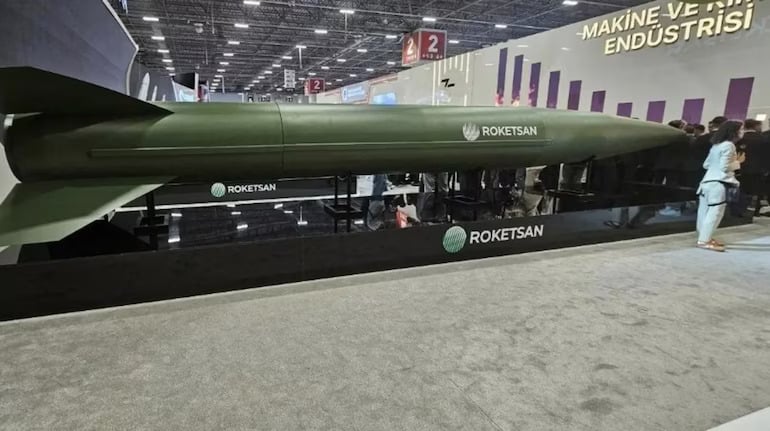The Tayfun Block-4 hypersonic missile has emerged as Turkey’s most advanced indigenous weapon, marking a significant milestone in the country’s defense capabilities. Capable of reaching speeds exceeding Mach 5, this missile, unveiled by the defense giant Roketsan, highlights Ankara’s aspirations to establish itself as a formidable technological and strategic power within its region.
Global Hypersonic Arms Race
With the introduction of the Tayfun Block-4, Turkey joins the ranks of major military powers like the United States, China, and Russia in the global hypersonic arms race. This development underscores Turkey’s commitment to indigenous innovation and demonstrates its growing military-industrial maturity.
Evolution of the Tayfun Missile Program
The Tayfun missile program commenced in the early 2020s as part of Turkey’s broader strategy to diminish its reliance on foreign defense supplies. Led by Roketsan—founded in 1988—the initiative draws on early experiences gained from collaborations with China’s CPMIEC related to ballistic missile technology.
Testing for the Tayfun began in October 2022, with the missile successfully demonstrating a range of over 560 kilometers. Subsequent enhancements to the Block-4 variant integrate hypersonic glide capabilities, emphasizing its challenge to traditional missile defense systems.
Tayfun Block-4: Technical Specifications
The specifications of the Tayfun Block-4 missile are impressive:
- Speed: Ranges from Mach 5.5 to Mach 8
- Range: 800 to 1,000 kilometers
- Accuracy: 5-meter Circular Error Probable (CEP)
- Warhead: 750 kg of conventional high explosive
- Guidance System: Combines GPS, GLONASS, and INS (Inertial Navigation System)
- Dimensions: Length between 6.5 and 10 meters, and diameter ranging from 610 to 938 mm
- Launch Platform: Utilizes mobile transporter erector launchers
The missile’s supersonic speed, agility, and advanced guidance capabilities allow for accurate strikes in complex environments, including those where GPS is compromised.
The Significance of Hypersonic Technology
Hypersonic weapons differ fundamentally from traditional ballistic missiles by flying at lower altitudes and altering trajectories mid-flight, which complicates detection and interception. This capability gives nations that employ such technology a decisive edge in military engagements.
Turkey’s Position in the Hypersonic Landscape
In the current landscape, the status of various countries concerning hypersonic missile capabilities highlights Turkey’s strategic advancements:
- Turkey: Tayfun Block-4—Operational at speeds of 5.5 to 8 Mach with a range of 800 to 1,000 km.
- Russia: Kinzhal, Zircon—Operational up to Mach 10 with an extensive range beyond 1,000 km.
- China: DF-17—Operational at speeds of 5 to 10 Mach and ranges between 1,800 to 2,500 km.
- USA: ARRW—In testing phase with speeds exceeding 5 Mach and a range of about 1,000 km.
Strategic Implications: Reshaping the Eastern Mediterranean
From its launch sites within Turkey, the Tayfun Block-4 can target various critical areas, including:
- Greece (including major military sites in Athens)
- The entirety of Cyprus
- Selected regions in Syria, Lebanon, and Israel
- Key energy and military infrastructures across the Eastern Mediterranean
The introduction of this missile significantly bolsters Turkey’s "Mavi Vatan" (Blue Homeland) maritime policy, facilitating mobile and precise strikes while enhancing strategic positioning in resource-rich maritime zones.
NATO Dynamics and Regional Reactions
Turkey’s capabilities prompt a reconsideration of NATO’s dynamics, particularly as its missile system explicitly targets Greece, another alliance member, raising questions about cohesion within the alliance.
Responses have been swift, with Greek officials denouncing the missile’s implications as provocative and counterproductive, whereas Cyprus, due to its proximity, faces heightened vulnerability. The European Union has also expressed concern over Turkey’s military assertiveness in the region.
Meanwhile, the United States appears to support Greece while navigating the complexities of maintaining unity within NATO amidst Turkey’s burgeoning military capability.
Turkish Defense Industry Growth: Roketsan’s Ascendancy
Roketsan has emerged as a leader in Turkey’s missile and rocket development, managing over 1,300 defense projects and exporting to more than 180 countries.
The transformation since 2002 is notable:
- Domestic Production: Increased from 20% to over 70%
- Export Revenue: Rose from negligible figures to approximately 7.2 billion USD
- Active Projects: Grew from 621 to 1,380
This progress has significantly reduced Turkey’s dependency on foreign suppliers, enabling greater freedom in its weapons development efforts.
Challenges and Risks Ahead
Despite the advancements, several challenges remain:
-
Strategic Risks: The potential to incite an arms race among regional powers such as Greece, Egypt, and Israel and the increased chances of miscalculations during crises due to the swift response times required.
-
Export Limitations: The missile is constrained by the Missile Technology Control Regime (MTCR), which regulates exports of missiles over certain payload and range thresholds.
-
Economic Factors: Sustaining the hypersonic program can be financially burdensome. Economic instability, including currency fluctuations and debt, may hinder funding.
- Technical Demands: Developing advanced materials and integrating these missiles effectively into real-world combat scenarios necessitate robust systems and support networks.
Future of Turkish Hypersonic Development
Roketsan is reportedly exploring longer-range systems, such as the Cenk medium-range ballistic missile. Plans to incorporate artificial intelligence, scramjet engines, and improved target discrimination technologies are already underway. Future investments in hypersonic defense systems may also be in store as the race for hypersonic tech expands globally.
Conclusion: A Defining Moment
The Tayfun Block-4 marks a watershed moment for Turkey, signifying its capacity to independently forge next-generation weaponry and consolidate its status as a regional power. The missile enhances Turkey’s deterrence capabilities, reinforces its naval strategies, and amplifies its influence throughout the Eastern Mediterranean. However, it simultaneously poses risks to regional stability and complicates the traditional dynamics within NATO.
As additional nations pursue similar advancements, Turkey’s developments in hypersonic technology will inevitably shape future frameworks for arms control, alliance politics, and deterrence strategies, establishing a new paradigm in modern warfare.










